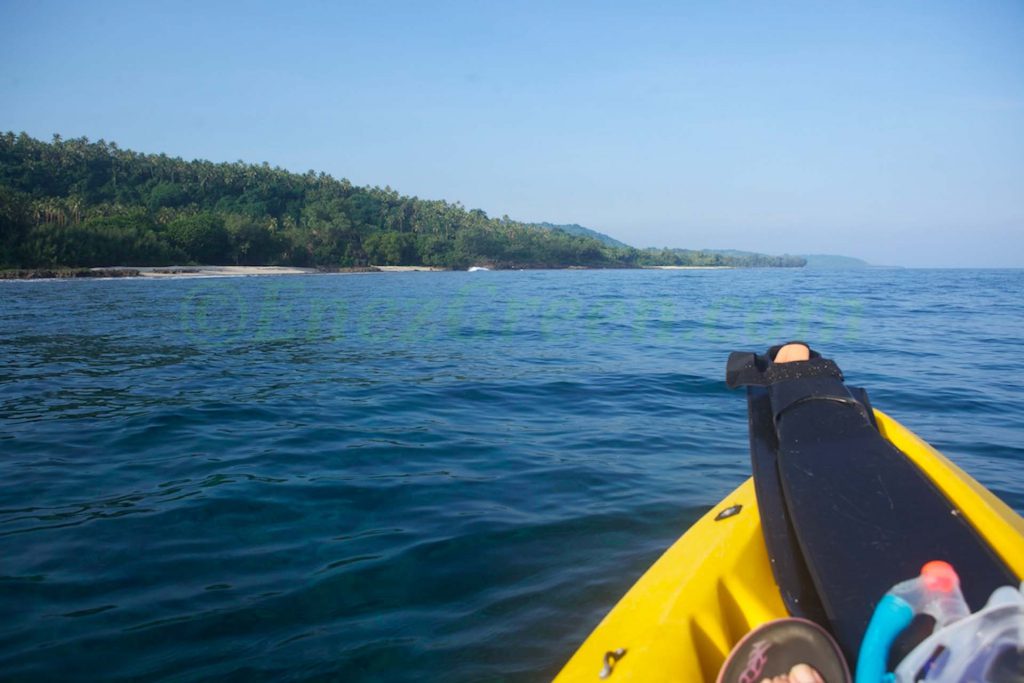Tongoa a legendary underwater site
When driving on the water bounded by north Epi, Tongoa and Emae east to the southwest, it is impossible to forget the presence of the volcano purring near the hull. A presence that turns out to be an excellent stimulant for people with imagination…
Discovery of biodiversity around a submarine volcano
For snorkeling enthusiasts who are fit, it is possible to combine a coastal kayak trip with launching equipped with fins, mask and snorkel; and you evolve into the water by gently pulling the kayak one end secured shoulder.
The show is striking underwater. Coral comes in all shapes and the most dazzling colors. The succession of drop offs, overhangs and small canyons are a 3D world dizzying.
Amid this backdrop fish abound clouds of all shapes and colors featuring designs that a painter could not imagine… By observing the interaction between different species of this ecosystem, you find yourself hypnotized by life scenes which change every moment. With over 450 species of fish identified in the archipelago, biodiversity is particularly rich on this site submarine.
Beyond the reef fauna, encounters with predators are frequent; one can observe groups kingfish coursing their prey up scratch the surface, or admire the agility of a loach surprising its prey round a rock, or spot a moray eel out of his refuge to greet you…
Diving on the wall of Tongoa
To discover scuba diving site, the only way is by boat there with his own equipment. There is as yet no filling station or to Tongoa nor Epi. The ideal is to have a good size inflatable annex with a marine area that ensures security and divers who dropped just above the drop-offs.
Monitoring of the marine is essential because of the presence of serious currents and the frequent agitation of the sea there.
Once immersed in the falling Tongoa, divers can measure the beauty of its topography and its biodiversity. The site is often visited by pelagics such as dog-tooth tuna, white tip sharks, rays… Divers evolve over an active volcano and along a crater… An incredible immersion that remains engraved forever in the memory of divers who have the privilege to experience this.
One of the most active submarine volcanoes in the archipelago
This is a cataclysmic eruption caused in the year 1452 – one of the largest ever recorded on earth as equivalent to 2 million Hiroshima atomic bombs value – which is at the origin of the separation of the island between Kuwae both islands Tongoa and Epi.
This huge eruption had a considerable impact in the region but also in the whole world is facing a general cooling.
A huge crater was formed underwater in the archipelago nearly 1,000 meters deep and explosion generated a massive tsunami while sending a phenomenal amount of dust, stones and magma into the atmosphere. The dust has probably been circulating throughout the Southern Hemisphere for a long time and have also impacted the northern hemisphere.
The legend of Kuwae which is transmitted orally between generations, remains anchored in the memory of the people of Vanuatu.
In addition, several significant events were reported during the same period in various regions of the planet. In Sweden, taxes on the crops in the same period are near zero, the analysis of the pines on the west coast of the USA shows traces of frost, while in England the oak used for the realization of portraits on the period 1453 -55 has closely spaced growth rings. Similarly, tree growth in Europe as in China was reduced between 1453 and 57. It is reported in the history of the Ming Dynasty, in spring 1453, continuous snowfall began threatening the crops and made kill thousands of people in six Chinese provinces. In Europe, during the siege of Constantinople between April and May 1453, it is noted specifically that May 22, 1453, the Constantinople symbol moon rose with a black veil, as announced by prophecy, and four days later the city was surrounded by a thick fog inexplicable level climate at this time of the year. Similarly, the unusual presence of reddish lights is reported around the battlefield. In addition, samples in Arctic ice has enabled a precise dating for 10 years near the traditional estimate.
A huge underwater crater 1,000 meters deep
More recently, in 1996, archaeologists from the National Museum of Vanuatu supported by their counterparts from the Foundation for the Cultures of the South Pacific, sponsored by the Australian Government and those of the University of Canberra and the Japanese Sasakawa Foundation, discovered and recorded during excavations, the presence of a significant layer of ash and traces of a tsunami.
It was concluded that the crater that was to culminate in the initial Kuwae Island at the altitude of 1,100 meters had collapsed to reach a depth of 1000 meters below the level of the sea. The large quantities of water came into contact with the magma had repercussions thousands of times greater than those that were observed during the 2010 volcanic eruption in Iceland.
The submarine volcano located between Epi and Tongoa, and identified by the name of PPE B is reviewed regularly and is considered active and potentially dangerous.



